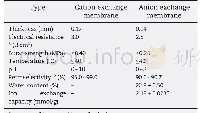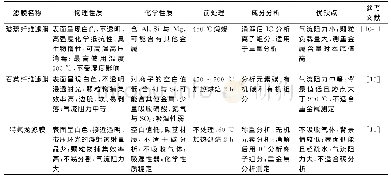《Table 2–The main properties of the ion exchange membranes used in the experiment.》
 提示:宽带有限、当前游客访问压缩模式
提示:宽带有限、当前游客访问压缩模式
本系列图表出处文件名:随高清版一同展现
《Comparative studies on fouling of homogeneous anion exchange membranes by different structured organics in electrodialysis》
aMeasured in 0.5 mol/L NaCl solution at 25°C.bMeasured between 0.5 mol/L and 0.1 mol/L solutions at 25°C.
The tests of membrane fouling were carried out by measuring the changes in the desalination rate of the AEM when different organic compounds were present in the dilute compartment in an ED apparatus,shown in Fig.1(Zhao et al.,2017).The membrane stack,composed of one fresh AEM and two fresh CEMs,was divided into dilute,concentrated,and electrode compartments.The initial solution in the dilute compartment was 500 mL of 0.1 mol/L NaCl and one of the organic compounds(shown in Table 1)with a concentration of 150 mg/L,and the feed solution in the concentrated compartment was 500 mL of 0.1 mol/L NaCl.The solutions in the two different beakers were circulated through the dilute and concentrated compartments,respectively,and then flowed into the two beakers.The feed solution was kept at a constant temperature of 25°C by a thermostatic bath during the experiments.The electrode rinse solution was 500 mL of 0.1 mol/L Na2SO4.All the solutions were circulated by a peristaltic pump at a flow rate of 100 mL/min.The effective area of each membrane was 50 cm2(5 cm×10 cm).The test of membrane fouling was carried out at a voltage of 4.0 V.The electrical conductivity of the solution in the dilute compartment was measured online by a conductivity meter(S230,SevenCompact,Mettler Toledo).Each fouling experiment with the same type of AEM was repeated three times and the result shown is the average of the three measurements unless otherwise noted.After each test,the used AEM was rinsed using ultrapure water and was then air-dried or stored in ultrapure water for further characterization.
| 图表编号 | XD0033519600 严禁用于非法目的 |
|---|---|
| 绘制时间 | 2019.03.15 |
| 作者 | Zhijuan Zhao、Shaoyuan Shi、Hongbin Cao、Yujiao Li、Bart Van der Bruggen |
| 绘制单位 | Division of Environment Technology and Engineering, CAS key Laboratory of Green Process and Engineering, Beijing Research Center of Process Pollution Control, State Key Laboratory of Biochemical Engineering, Institute of Process Engineering, Chinese Acade |
| 更多格式 | 高清、无水印(增值服务) |




![Table 2 Distribution Coefficients of the recycled M[H]-11.9 lithium ion-sieve membrane](http://bookimg.mtoou.info/tubiao/gif/RGJT201903033_11400.gif)
